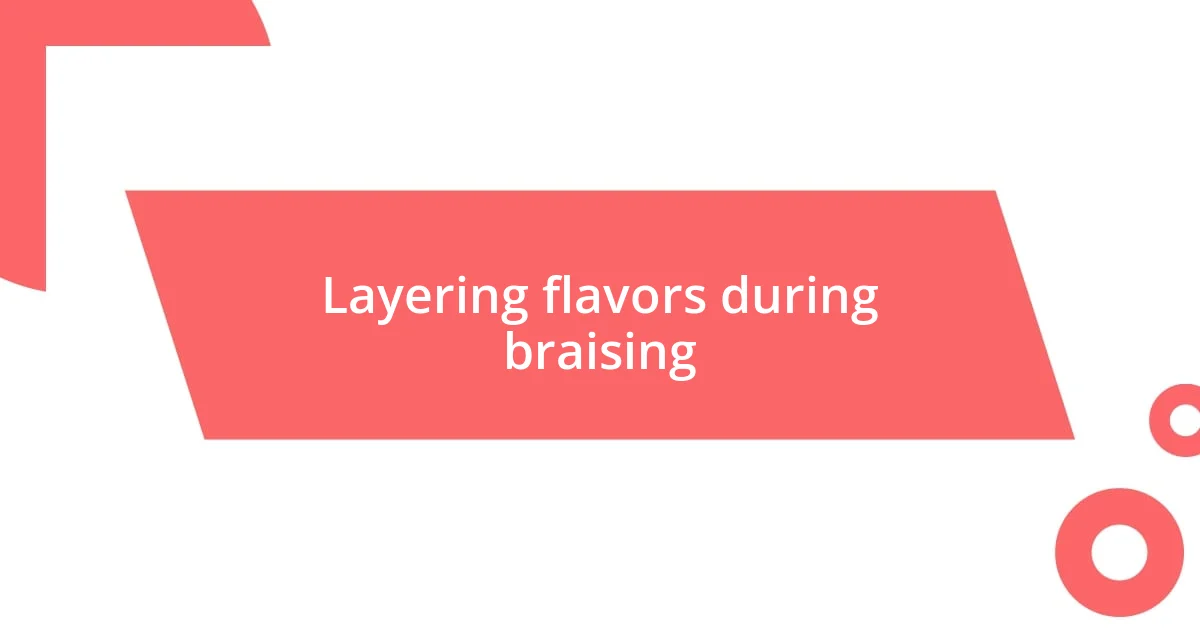Key takeaways:
- Braising combines searing and slow cooking, allowing for deep flavors in meats and vegetables, enhanced by the right quality ingredients.
- Building a flavor base is essential; using aromatics, proper searing, and timely additions can transform a dish into a complex culinary experience.
- Adjusting seasonings and adding finishing touches like acidity and texture significantly enhance the dish’s final flavor and presentation, celebrating the cooking process.

Understanding the braising technique
Braising is a fascinating cooking method that combines both moist and dry heat to create deep flavors in meats and vegetables. I remember the first time I tried braising; the aroma filled my kitchen and made my heart race with anticipation. Isn’t it incredible how a simple technique can completely transform the texture and taste of an ingredient?
At its core, braising involves searing food at a high temperature, followed by slow cooking in a bit of liquid. This process not only tenderizes tougher cuts of meat but also allows for a complex layering of flavors. When I marinated a chuck roast in red wine and herbs before braising it, the outcome was nothing short of a revelation. Have you ever experienced that moment of discovery when a dish surprises you with its richness?
One of the best parts about braising is the versatility it offers; you can use a multitude of ingredients to get desired flavors. I often experiment with different broths and spices, and I remember when I braised pork with apple cider and mustard. That dish was comforting and showcased how braising nurtures the ingredients, instilling warmth in each bite. It’s like giving the food a cozy hug!

Choosing the right ingredients
Choosing the right ingredients is crucial in braising, as they ultimately determine the depth and complexity of flavors in your dish. I once decided to braise a lamb shank, and I thought about what would complement its rich taste. Using a combination of aromatic vegetables like onions, carrots, and celery, along with a full-bodied red wine, transformed my dish into a luxurious experience that had my friends asking for seconds.
In my experience, the quality of your ingredients can make a world of difference. For example, I learned early on that using fresh herbs, like rosemary or thyme, vastly enhances the aroma and flavor profile of the dish. Have you ever noticed how the scent of fresh herbs can transport you back to a wonderful meal? It’s almost magical. Pairing the right meat with the appropriate liquid is another vital part of the process; using chicken broth for poultry or stock for beef creates a robust foundation for the flavors to develop.
When it comes to vegetables, their role shouldn’t be underestimated. I often incorporate root vegetables, which not only add taste but also provide a delightful sweetness as they braise. There’s an amazing moment when those veggies tenderize and mingle with the cooking liquid, filling the kitchen with a warm, inviting aroma. It’s hard not to love the anticipation that builds while waiting for a braise to finish, knowing that the right ingredients lead to a satisfying culinary journey.
| Type of Ingredient | Example |
|---|---|
| Meat | Chuck roast or lamb shank |
| Liquid | Red wine or chicken broth |
| Aromatics | Onions, garlic, or shallots |
| Vegetables | Carrots or root vegetables |
| Herbs | Fresh rosemary or thyme |

Building a flavor base
Building a flavor base is where the magic begins in braising, and it sets the tone for the entire dish. I can still recall the moment I first sautéed onions and garlic in a heavy-bottomed pot—those aromatic notes filled my kitchen and danced around my senses, creating an immediate connection to the dish I was about to prepare. In braising, this initial phase involves layering flavors through various ingredients, allowing them to meld together beautifully as they cook.
Here’s a useful breakdown of what goes into building that foundation:
- Aromatics: Start with onions, garlic, or shallots for that essential flavor backdrop.
- Searing: Don’t skip this step; searing your meat creates a rich crust that enhances the overall taste.
- Deglazing: Use your liquid of choice to scrape up the browned bits from the bottom of the pot. This not only adds depth but also encourages a delightful umami experience.
- Balance: Layer in acidic elements, like a splash of vinegar or citrus, to brighten the flavors.
- Herbs and Spices: Fresh herbs like parsley or bay leaves and spices can introduce complexity and warmth.
I’ve learned that the symphony of flavors deepens as the ingredients slowly meld during cooking. I remember as I added a splash of balsamic vinegar to my braised beef, the pungent sweetness transformed the dish, lifting it to extraordinary heights. Every element plays its part, and together, they create a delicious narrative in each bite. It’s truly remarkable how something so simple can develop into a complex and intensely flavorful meal.

Layering flavors during braising
Layering flavors during braising is an enchanting process that requires careful attention and a bit of intuition. I’ve found that adding specific ingredients at different stages elevates the dish tremendously. For instance, during one braise of pork shoulder, I chose to toss in some dried apricots halfway through cooking. The sweetness unraveled beautifully, creating a contrast that balanced the savory meat, and each bite became a delicious surprise. Have you ever tried adding a touch of sweetness mid-braise?
I also like to think of flavor layering as building a story with each ingredient representing a chapter. When I braised a chuck roast recently, I started with leeks and carrots, then introduced smoked paprika as the dish simmered. The smokiness provided depth that lingered on my palate long after the meal was over. It’s fascinating how creating layers can transform the simplest bowl of food into a tapestry of flavors that tell a compelling tale with every forkful.
Don’t underestimate the power of timing and patience. As the dish cooks, I often sneak a taste, adjusting the seasoning or adding a pinch of salt to enhance the existing flavors. The last-minute addition of fresh herbs right before serving is like a finishing touch, adding a burst of brightness that invites you to dig in. In my experience, it’s these thoughtful touches that turn a good braise into an exceptional one, making it memorable for everyone at the table.

Adjusting seasonings throughout cooking
As I’ve honed my braising skills, one crucial lesson I’ve learned is the importance of adjusting seasonings as I go. It can be easy to overlook this step, but a quick taste halfway through can reveal a world of differences. I remember a time I was braising chicken when I hit a flavor wall; it felt flat, lacking the depth I desired. Just a pinch of salt and a dash of pepper transformed it into a comforting, savory dish that I couldn’t wait to share.
When I’m deep into the cooking process, I often ask myself, “Does it need more acidity?” A splash of vinegar or a twist of lemon zest can brighten the flavors in a matter of seconds. One of my favorite moments was adding a touch of orange zest to a beef stew; it was like a burst of sunshine on a cloudy day that helped balance the dish beautifully. This instinct for adjustment comes from listening to the food, letting it guide me on its flavor journey.
Wrapping up the cooking process, I find that adding fresh herbs at the end can truly elevate the dish. Just the other night, I was stirring a pot of braised lamb shanks and felt it needed a lift. That final flourish of chopped mint made all the difference, transforming it into a fragrant, vibrant masterpiece. Have you ever experienced that sudden realization that a dish is just a dash away from perfection? It’s moments like these that make cooking so rewarding, the act of creation turning into a delightful communion with the ingredients.

Finishing touches for enhanced flavor
When it comes to finishing touches, I believe garnishing is more than just aesthetics; it’s an enhancement of flavor. Recently, after a long day of braising a hearty beef pot roast, I remembered to top it with a sprinkle of flaky sea salt and some fresh chopped parsley right before serving. That instant burst of brightness combined with the crunch of the salt made each bite feel like a celebration. Have you ever noticed how a simple garnish can transform a dish from ordinary to extraordinary?
I often find myself reflecting on the impact of acidity as a finishing touch. During a braise of chicken thighs with mushrooms, I discovered that squeezing a bit of lemon juice over the dish just before serving brought the flavors to life. It was like unveiling a hidden layer that tied the savory elements together beautifully. The contrast created by that acidity is a trick I keep in my back pocket—it’s always fascinating how just a splash can make such a difference.
In my journey of flavor creation, I’ve also learned that texture can elevate a dish just as much as taste. After braising a batch of short ribs, I decided to add toasted breadcrumbs mixed with herbs on top. The crunchiness provided a delightful contrast to the tender meat, and the aroma that filled my kitchen was heavenly. Isn’t it remarkable how a simple addition can turn a comforting meal into something memorable? That’s the magic I love to explore in my cooking.

Serving and enjoying the dish
When it’s time to serve the dish, I relish the moment of transformation—the transition from creation to celebration. Recently, after braising a vibrant ratatouille, I plated it with care, letting the colors pop against the white dish. I can still recall the proud feeling that washed over me as I drizzled some high-quality olive oil on top; it was like adding the final brushstrokes to a painting. Isn’t it fascinating how presentation can make a dish feel more special?
As I gather my family around the table, I can feel the excitement in the air. I remember one evening where I served braised pork belly, and the aroma enveloped the room, drawing everyone in like a warm hug. As I plated each serving, I couldn’t help but smile at the faces lit up by anticipation. Sharing a well-crafted meal is such a gift; it creates connections and ignites conversations that linger long after the plates are cleared.
In the moment of savoring the dish, I find joy in the shared experience. As we sat together to enjoy that pork belly, I watched as everyone savored the bite, relishing the melt-in-your-mouth goodness. It reminded me that good food doesn’t just fill the stomach; it feeds the soul. Have you ever paused amidst a meal to truly appreciate the flavors, noticing how they tell a story? That’s where the magic lies for me, turning nourishment into an experience worth cherishing.















